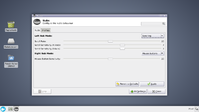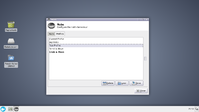elvissteinjr
Very Active Member
Leaving this here for the folks who are concerned about Zenity scripts.
I've taken up on the task of contributing GUI tools for pyra-specific settings.
They may not be the most fancy dialogs out there, but my overall goal is to have them not stand out and rather integrate into the desktop experience.
Notable features are:

It's written in C++ with wxWidgets.
Current Status
Why I chose the Nub Settings as the first dialog to work on, when it wasn't even Zenity
Well, it the one that surely remains mostly the same on the backend. Others won't exist anymore or may be replaced by stuff newer DE versions or the Debian repo provides.
The Pandora Nub Configurator was fine for the most part and certainly not in an unfixable state, far from that, but for consistency's sake I'd implement it anyhow at some point.
It was namely a bit cramped and also showed all options at once, even if they weren't relevant.
The new version of the Nub settings is a bit more compact and hides sliders for inactive options.
Profiles have been moved to a second tab with slightly more advanced profile management (renaming and reordering).
And of course the stuff mentioned at the beginning.
Command-line interface for profile management from scripts also exists, but it's a bit different from the Nub Configurator's one.
I've attached screenshots of it, one from within XFCE Settings Manager and one standalone.
Pandora version is on the repo as Nub Settings X, although most advantages can't really be used there.


Now for the rest of Pandora's custom settings, here's a list and my thoughts about them. Feel free to correct me when I'm wrong, of course. This is with thinking of XFCE 4.12 as default.
Frankly, I haven't dug deep when it comes to the implementation details, so I kindly accept pointers to them if there's anything set in stone already.
That's about it for now. I won't be super fast with writing them as time is limited, but I will deliver eventually.
@OS-devs:
This is also meant as proposal for integration into the default install.
I don't really have any experience in Linux deployment, but I have a configuration that builds a Debian package already.
What are the requirements? Do you need an extra source git to clone from (currently I just have everything offline)? Do you prefer to do the packaging setup entirely yourself?
My current plan is to have all dialogs in one executable. Not sure if that hurts the Linux philosophy too much. If separate ones for each are preferred, I'll set it up like that instead.
I've taken up on the task of contributing GUI tools for pyra-specific settings.
They may not be the most fancy dialogs out there, but my overall goal is to have them not stand out and rather integrate into the desktop experience.
Notable features are:
- Multilanguage support (English and German included as of now)
- Scrollable dialogs (they are all still designed to fit on screen, of course)
- XFCE Settings Manager integration
- XFCE-Style headers (can be turned off via command-line switch)
It's written in C++ with wxWidgets.
Current Status
- Nubs -> Done, at least on Pandora feature-level, may be extended later on
- Rest -> See below
Why I chose the Nub Settings as the first dialog to work on, when it wasn't even Zenity
Well, it the one that surely remains mostly the same on the backend. Others won't exist anymore or may be replaced by stuff newer DE versions or the Debian repo provides.
The Pandora Nub Configurator was fine for the most part and certainly not in an unfixable state, far from that, but for consistency's sake I'd implement it anyhow at some point.
It was namely a bit cramped and also showed all options at once, even if they weren't relevant.
The new version of the Nub settings is a bit more compact and hides sliders for inactive options.
Profiles have been moved to a second tab with slightly more advanced profile management (renaming and reordering).
And of course the stuff mentioned at the beginning.
Command-line interface for profile management from scripts also exists, but it's a bit different from the Nub Configurator's one.
I've attached screenshots of it, one from within XFCE Settings Manager and one standalone.
Pandora version is on the repo as Nub Settings X, although most advantages can't really be used there.


Now for the rest of Pandora's custom settings, here's a list and my thoughts about them. Feel free to correct me when I'm wrong, of course. This is with thinking of XFCE 4.12 as default.
- CPU-Settings -> Missing, from what I've heard, overclocking only works on fixed values. Can't tape a lot around single selections if that's the case.
- Date and Time -> Missing, maybe use something existing like the one from gnome-system-tools instead of writing our own
- LED-Settings -> Missing, needs implementation details first
- Lid-Settings -> XFCE Power Manager Settings
- Startup Manager -> Debian Login Screen/XFCE Session Settings?
- TV-Out-Settings -> Obsolete/XFCE Display Settings
- Video-Settings -> Obsolete? (are there still hardware scalers and is there anything to control?)
Frankly, I haven't dug deep when it comes to the implementation details, so I kindly accept pointers to them if there's anything set in stone already.
That's about it for now. I won't be super fast with writing them as time is limited, but I will deliver eventually.
@OS-devs:
This is also meant as proposal for integration into the default install.
I don't really have any experience in Linux deployment, but I have a configuration that builds a Debian package already.
What are the requirements? Do you need an extra source git to clone from (currently I just have everything offline)? Do you prefer to do the packaging setup entirely yourself?
My current plan is to have all dialogs in one executable. Not sure if that hurts the Linux philosophy too much. If separate ones for each are preferred, I'll set it up like that instead.


